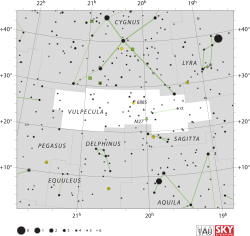14 Vulpeculae
| 14 Vulpeculae | |
 | |
| Observationsdata Epok: J2000.0 | |
|---|---|
| Stjärnbild | Räven |
| Rektascension | 19t 59m 10,53825s[1] |
| Deklination | +23° 06′ 04,6049″[1] |
| Skenbar magnitud () | +5,68 (V)[2], +5,660 ± 0,009 (V)[3] |
| Stjärntyp | |
| Spektraltyp | F1 Vn [4] |
| B–V | 0,345 ± 0,004[5] |
| Astrometri | |
| Radialhastighet () | -38,00 ± 3,7[6] km/s |
| Egenrörelse (µ) | RA: -70,16 ± 0,64[1] mas/år Dek.: 2,12 ± 0,47[1] mas/år |
| Parallax () | 20,36 ± 0,75[1] |
| Avstånd | 160 ± 6 lå (49 ± 2 pc) |
| Absolut magnitud () | 2,23[2] |
| Detaljer | |
| Massa | 1,52[7] M☉ |
| Radie | 2,56[8] R☉ |
| Luminositet | 11,09[2] L☉ |
| Temperatur | 6 938 ± 236[7] K |
| Metallicitet | -0,36 (Fe/H)[6] dex |
| Vinkelhastighet | 150[9] km/s |
| Ålder | 1,743[7] miljarder år |
| Andra beteckningar | |
| GSC 02141-02712[10], 2MASS J19591053+2306050[10], SAO 88016[10], HD 189410[10], HIP 98375[10], HR 7641[10], IRAS 19569+2257[10], BD+22 3872[10], GC 27688[10], GCRV 12330[10], HIC 98375[10], N30 4420[10], PLX 4734.2[10], PLX 4734.20[10], PPM 110149[10], ROT 7637[10], TD1 25828[10], TYC 2141-2712-1[10], uvby98 100189410[10], YZ 22 7397[10], WEB 17361[10], Gaia DR2 1833321397510986496[10], 14 Vul, Gaia DR3 1833321397515530496[10], TIC 424048358[10] och AG+22 2065[10][11] | |
14 Vulpeculae, som är stjärnans Flamsteed-beteckning, är en ensam stjärna[12] belägen i den södra delen av stjärnbilden Räven, visuellt belägen i närheten av Hantelnebulosan (M 27), även om den i verkligheten befinner sig betydligt närmare Jorden.[13] Den har en skenbar magnitud av ca 5,68[2] och är svagt synlig för blotta ögat där ljusföroreningar ej förekommer. Baserat på parallaxmätning inom Hipparcosuppdraget på ca 20,4[1] mas, beräknas den befinna sig på ett avstånd på ca 160 ljusår (ca 49 parsek) från solen. Den rör sig närmare solen med en heliocentrisk radialhastighet av ca -38 km/s.[6]
Egenskaper
14 Vulpeculae är en gul till vit stjärna i huvudserien av spektralklass F1 Vn,[4] där 'n'-notationen anger suddiga spektrallinjer i stjärnans spektrum på grund av snabb rotation med en projicerad rotationshastighet på 150 km/s.[9] Den har en massa som är ca 1,5[7] solmassor, en radie som är ca 2,6[8] solradier och utsänder ca 11[2] gånger mera energi än solen från dess fotosfär vid en effektiv temperatur på ca 6 900 K.[7]
Referenser
- Den här artikeln är helt eller delvis baserad på material från engelskspråkiga Wikipedia, 14 Vulpeculae, 7 september 2020.
Noter
- ^ [a b c d e f] van Leeuwen, F. (2007), "Validation of the new Hipparcos reduction", Astronomy and Astrophysics, 474 (2): 653–664, arXiv:0708.1752, Bibcode:2007A&A...474..653V, doi:10.1051/0004-6361:20078357.
- ^ [a b c d e] Anderson, E.; Francis, Ch. (2012), "XHIP: An extended hipparcos compilation", Astronomy Letters, 38 (5): 331, arXiv:1108.4971, Bibcode:2012AstL...38..331A, doi:10.1134/S1063773712050015.
- ^ ”Basic data: V* 14 Vul – High proper-motion Star” (på engelska). Centre de Données astronomiques de Strasbourg. http://simbad.u-strasbg.fr/simbad/sim-basic?Ident=14+Vul&submit=SIMBAD+search. Läst 7 juli 2019.
- ^ [a b] Abt, Helmut A.; Morrell, Nidia I. (1995), "The Relation between Rotational Velocities and Spectral Peculiarities among A-Type Stars", Astrophysical Journal Supplement, 99: 135, Bibcode:1995ApJS...99..135A, doi:10.1086/192182.
- ^ van Leeuwen (2007). ”Hipparcos, the New Reduction” (på engelska). http://vizier.u-strasbg.fr/viz-bin/VizieR-5?-out.add=.&-source=I/311/hip2&HIP=98375. Läst 7 juli 2019.
- ^ [a b c] Casagrande, L.; et al. (2011), "New constraints on the chemical evolution of the solar neighbourhood and Galactic disc(s). Improved astrophysical parameters for the Geneva-Copenhagen Survey", Astronomy & Astrophysics, 530 (A138): 21, arXiv:1103.4651, Bibcode:2011A&A...530A.138C, doi:10.1051/0004-6361/201016276.
- ^ [a b c d e] David, Trevor J.; Hillenbrand, Lynne A. (2015), "The Ages of Early-Type Stars: Strömgren Photometric Methods Calibrated, Validated, Tested, and Applied to Hosts and Prospective Hosts of Directly Imaged Exoplanets", The Astrophysical Journal, 804 (2): 146, arXiv:1501.03154, Bibcode:2015ApJ...804..146D, doi:10.1088/0004-637X/804/2/146.
- ^ [a b] ”14 Vulpeculae” (på engelska). Universe Guide. https://www.universeguide.com/star/14vulpeculae. Läst 7 juli 2019.
- ^ [a b] Bernacca, P. L.; Perinotto, M. (1970), "A catalogue of stellar rotational velocities", Contributi Osservatorio Astronomico di Padova in Asiago, 239 (1), Bibcode:1970CoAsi.239....1B.
- ^ [a b c d e f g h i j k l m n o p q r s t u v w x y] SIMBAD Astronomical Database.[källa från Wikidata]
- ^ "14 Vul". SIMBAD. Centre de données astronomiques de Strasbourg. Hämatd 2018-04-13.
- ^ Eggleton, P. P.; Tokovinin, A. A. (September 2008), "A catalogue of multiplicity among bright stellar systems", Monthly Notices of the Royal Astronomical Society, 389 (2): 869–879, arXiv:0806.2878, Bibcode:2008MNRAS.389..869E, doi:10.1111/j.1365-2966.2008.13596.x.
- ^ Benedict, G. Fritz; McArthur, B. E.; Fredrick, L. W.; Harrison, T. E.; et al. (2003), "Astrometry with The Hubble Space Telescope: A Parallax of the Central Star of the Planetary Nebula NGC 6853", Astronomical Journal, 126 (5): 2549–2556, arXiv:astro-ph/0307449, Bibcode:2003AJ....126.2549B, doi:10.1086/378603.





